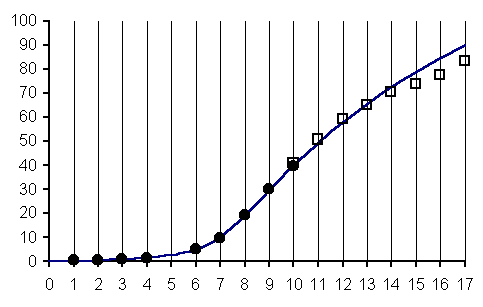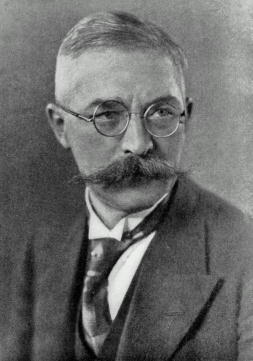Witte began his career as an astrologer in 1913 when he published his article "Thoughts on Colour, Number, Tone" [2], where he developed the ideas of Johannes Kepler, his compatriot, an astrologer and mathematician, particularly on the idea of harmony or the music of the spheres. This article discussed the mutual interrelation of planets' vibrations, as well as their relation to other natural oscillations and waves according to the tuning fork principle. But this article only was his first probing step.
| Plane | Ego | non-Ego (You) | ||
|---|---|---|---|---|
| Physical | Body | Sun (The day) |
Society in general | 0° Aries (Node of the Sun) |
| Psychic | Soul | Moon (The hour) |
Connections | Node (Node of the Moon) |
| Spiritual | Spirit | Meridian (MC) (The minute) |
The immediate environs |
Ascendant (ASC) (Node of the MC) |
| Planet | Principle | Function | Expression | Manifestation |
Cupido 262.5 years |
Integration | Union, coordination, synthesis | Society, marriage, creativity in the arts | Family, the community, corporations, clubs and other social groupings, works of art, artists |
Hades 360.66 years |
Disintegration | Disgust concerning evil, all ill and unpleasant, purification | The distant past, antiquity, secrecy, the seamy side of life | Ruins, slums, garbage, junk, excrements, sewers, city dump, swamps, bogs, quicksand, organic fertilisers, compost heap, worms, grubs, insects, illnesses |
Zeus 455.6 years |
Realisation and fulfilment | Leadership, creation, procreation | Purposeful activity, directed energy, controlled power | Fire, machinery, mechanisms, fire-arms, fuel, industrialisation, production targets, five-year plans and so on |
Kronos 521.8 years |
Mastery | Management | Rulership, authority, position, advantage | Governments, bureaucracies, princely hierarchies, heads of state, paterfamilias |
Apollon 576 years |
Comprehensiveness, extension, space | Expansiveness, enlargement of outlook, cross-cultural exchange | Breadth of experience, opportunity, large quantity of anything, great distance | Higher education, learning, erudition, science, commerce, trade, all peaceful enterprises |
Admetos 624 years |
Form, mass, inertia | Foundation, basis, focus, to mark time | Cyclical process, rotation, circulation, stagnation, primeval origins, condensation, compression, density, depth, finish, death | Nucleus, core, gravitation, bounded or repetitive motion (as of a piston), raw materials, ores, minerals, crystals, rock, deep within the earth, subterranean |
Vulcanus 663 years |
Dynamic equilibrium | Power, energy reserve | Sustained force or activity, energy, power | Great strength (physically, mentally, mechanically, and so on), potential energy, power plant |
Poseidon 740 years |
Light | Understanding, enlightenment | Truth, idea | Spirit, philosophy, wisdom, information |
|
|

Albert R. Timashev
August 20, 1998
References
- Alfred Witte, Regelwerk für Planetenbilder: Die Astrologie von morgen. Hamburg, 1928. (English translation: Witte-Lefeldt, Rules for Planetary-Pictures: The Astrology of Tomorrow, Witte-Verlag, Hamburg, Germany, 1996).
- Alfred Witte, Betrachtungen über Farbe, Zahl, Ton. Astrologische Rundschau, IV Jahrg., 1913.
- A. Witte, Sensitive Punkte. Astrologische Rundschau, X Jahrg., Dez. 1919.
- William Lilly, Christian Astrology, 1647.
- Ludwig Rudolph, Bedeutung der Planeten in den Häusern. Ludwig Rudolph (Witte-Verlag), Hamburg, 2.Auflage, März 1974. (English translation: Ludwig Rudolph, Meaning of the Planets in the Houses: The theory of the houses according to WITTE, Witte-Verlag, Hamburg, Germany).
- Robert A. Jacobson, The Language of Uranian Astrology, Uranian Publications, Inc., 1990.
- Michael Erlewine, Astrological Signs.
- The Influence of the Planet Pluto: Including an Ephemeris of Pluto, 1840-1960. Chicago: Aries Press, 1938. 26 pages booklet.
- Reinhold Ebertin, Kombination der Gestirneinflüsse. Ebertin-Verlag, Aalen/Württ. Erweiterte Neuauflage 1961. (English translation: Reinhold Ebertin, The Combination of Stellar Influences).
- Albert R. Timashev, "Generalized Golden Section and the Time Theory", report at the International Scientific Conference "New Ideas in Natural Sciences", St. Petersburg, Russia, June 1996.
- Udo Rudolph, Alfred Witte and Hamburg School of Astrology (article).
- Regelwerk - Neufassung von Ruth Brummund. Ludwig Rudolph (Witte-Verlag), Hamburg, 1.Auflage, 1979.
- Udo Rudolph, ABC für Planetenbilder. Deutsche Erstauflage 1996. Udo Rudolph Verlag, Hamburg.
Copyright © 1998-99 Albert R. Timashev
61621 visitors from August 28, 1998
If you have any comments or suggestions, please, E-mail
webmaster.

